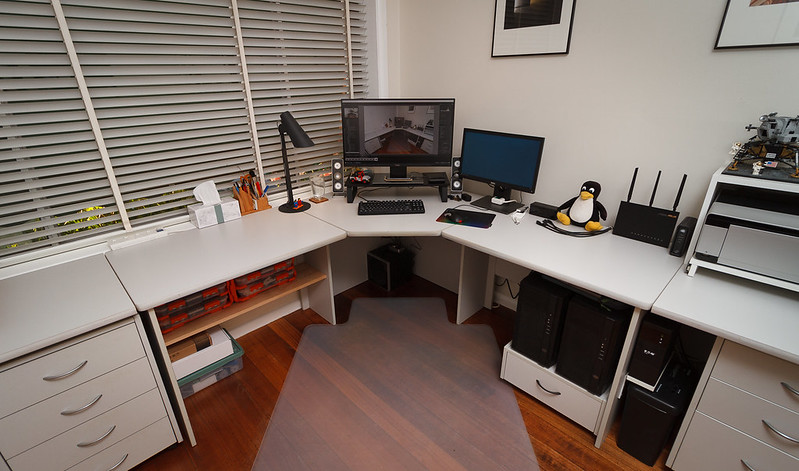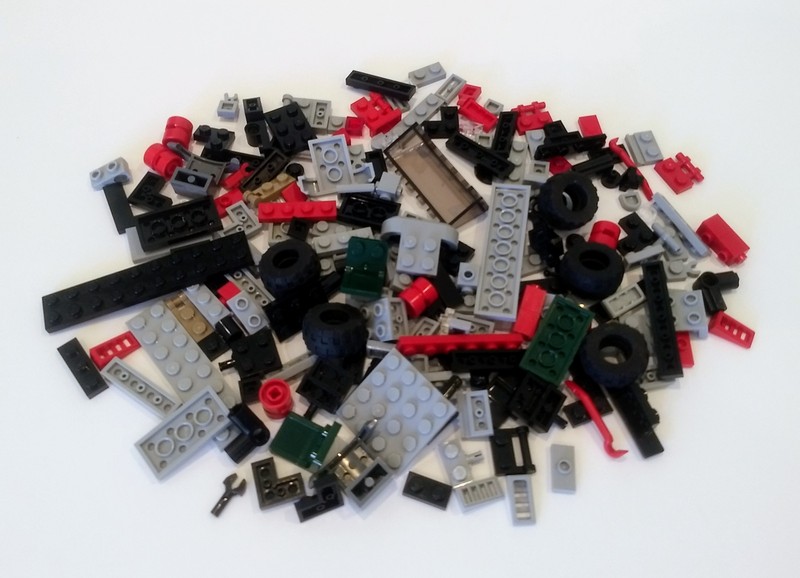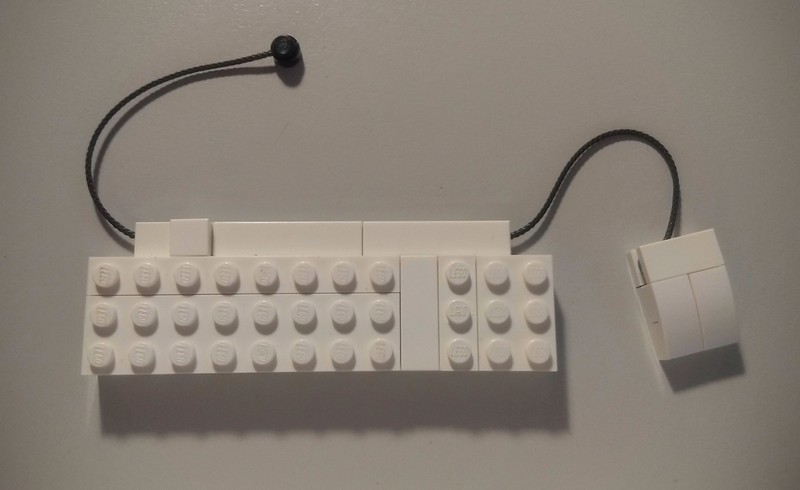My desk
Tuesday, January 25th, 2022 at 09:53pm
While I was recently required to stay at home I spent some of the time giving each room/area of my house a deep clean, for my study I took an updated panorama photo. This prompted a couple of questions about my setup so I decided to dust off a draft I started over a year ago, so where is an overly long post…
Most of the room can be seen in the panorama photos, but this is the main desk area:
Desk
The desk itself is an 1800x1800mm corner desk, importantly the sides are only 600mm deep (compared the 750mm you normally have for office furniture) which means that there is more usable space on the sides and less dead space in the corner. The corner depth might have been needed back in the day of deep CRT monitors, but not these days for LCD panels.
Back in 2012 I was looking in secondhand office furniture stores for another filing cabinet or similar when I came across a small 1200x600mm desk in the same light grey. It worked out quite nicely that it could be cut up to form additional side extensions.
I was able to find a secondhand desk that I could cut and use as side extensions, I originally only planned to extend one side, but both sides fit (along with some filing cabinets and shelves) perfectly in my study.
It was also at these secondhand furniture stores that I found two more drawer pedestals, but I will get to them shortly.
Left
I try to keep the left hand side clear so it can be used for things like mounting a photo, assembling electronics or putting together LEGO.
This set of drawers has typical office/study type items, while the other boxes contain a variety of electronics and home automation components. The clear+orange ones are the Tactix storage containers from Bunnings.
On the far right I have my printer and scanner. These sit under Billy height extensions (the one over the printer modified to be narrower) that serve as hutches. The printer and scanner are sitting on drawers so they can be slid forward when needed to be used.
Working area
The corner area of the desk is where I have my main and secondary displays, keyboard, mouse, speakers, lamp and a powerboard. All of these items are powered from another powerboard mounted under the desk as is a USB adapter for my phone, the Macbook power adapter and a bluetooth audio receiver.
It is not immediately obvious but attached to the stand for the secondary display is the switch for a (now discontinued) Eco Switch. This is a nice simple physical switch that lets me kill the power to everything in this section, it is so much quicker and easier than having to turn each item on or off.
- Main display is a Dell UP2716D that I am still quite happy with.
- My secondary display has been a variety of small used monitors, starting at a 15″, then a 19″ that was being disposed of when we moved offices, with the current being a new 20″ that I got at the start of lockdowns. I know Dell isn’t the best company, but their displays work for me.
- Of course the mouse is a Microsoft IntelliMouse Optical 1.1A. Because of where the join is on the desk I need to use a mouse pad, it was surprisingly hard to find one that was small, thin and didn’t have a fabric surface, this is a Razer Sphex V2 Mini.
- The keyboard is a Ducky One TKL side-printed mechanical keyboard with Cherry Brown keyswitches. For a long time I had stuck with a set of old HP keyboards but back in 2018 I looked around and worked out that I liked the feel of the Cherry Browns, the idea of TKL aka tenkeyless aka no number pad on the right also appealed. I had no interest in RGB lighting or excessive amounts of macros so this keyboard suits nicely.
- With the mouse being the oldest item in this section, the second oldest are the Logitech Z4 speakers which would date from somewhere around 2009. These are still going strong and I mostly like how the sub tucks away in the corner underneath and the speakers on the desk are quite small. I also like how there are two inputs, on the second one I have a bluetooth audio adapter, so I can play podcasts directly from my phone instead of through the computer.
- A currently hidden item is a webcam, this is mostly used for work meetings and for that it sits on top of the secondary display, but when I am not needing to use it I put behind the display on top of the stand.
- The final item in this section isn’t that visible, it is the two white USB-C adapters coming up to the right of my secondary display. These are for my work laptop which I will describe more below.
Computers and network
The next area of the desk are the items that are on all the time. A not a clock, modem and router, then two computers one my Windows desktop and the Linux box that acts as my file/media server, used for automating various things, and is also where I run Home Assistant. These are all running from a small Eaton UPS which gives me backup for a short power outage, but also stats on how much power these things are using.
The two computer cases are on top of what looks like another drawer pedestal, except it is only one draw high. This started out as a normal set of secondhand drawers, but I was able to cut it down to be just the single drawer. I didn’t want to put the cases up on the desk and they should not go directly on the floor, this was a nice alternative to the old Macintosh that I had previously used, plus gives storage for the bits and pieces directly related to these two computers.
Mounted to the back of this section of desk is an eight port USB hub connected directly to my Windows desktop. Two ports are for the printer and scanner, but another five are for the black cables that are sitting on the desk in front of Tux. These are for short term connection of things like hard drives or Arduninos for programming. I don’t have five because I expect to plug in five devices at once, but they are five different connections: B, mini-B, micro-B, micro-B 3.0 and a USB-C.
If you look closely there is a laptop sleeve and laptop sitting on top of the two computer cases. When the laptop is down there I am not in work mode.
Printer and scanner
Only part of the printer can be seen in the above photo, but the panorama shows that the remaining items of technology are my printer and scanner. Well, except for the shredder on the floor under the UPS.
There is nothing that special about the printer (an Epson R2800 that I got secondhand and is still giving good prints) or the scanner (an Epson V700 that can also do slides and negatives) themselves, but where I have them placed is unique. For a long time they were sitting on the desk and I was finding that things would accumulate on top, needing to be moved when I wanted to use the device.
To make best use of the space the the printer I picked up a Billy height extension unit, cut it down to be slightly wider than the printer and then build a sliding shelf for the printer. So I get the space to display Lego sets, but when I want to use the printer I slide it forward. It is a similar situation for the scanner, except I didn’t need to modify the narrower height extension and I mounted the sliding shelf to the top of the filing cabinet.
KVM and the work laptop
When I first switched to the current Dell 27″ display I was still using a dedicated KVM switch for the rare occasion when I needed to directly access the Linux box. By this point the KVM was quite old and despite being digital it was designed for VGA and PS/2. When I realised that the monitor has a built in KVM switch (switching USB instead of just keyboard and mouse) I removed a bunch of cable clutter by using that instead.
The Dell display also has an audio line-out port for audio that is coming over HDMI. Initially I thought I was just saving a bit of clutter by connecting the speakers to the display instead of over to the computer, but the real benefit came when I started working from home as the KVM was now also switching audio.
Going back to the white adapters I mentioned earlier, one is the typical USB-C to HDMI/USB/Power and the other is a USB-C to displayport. The end result is that I can grab my work laptop (a macbook) from under the desk, plug in the two adapters, keeping the lid closed, and then switch the inputs on my two monitors. This is what I consider “work mode” as the keyboard, mouse, displays, webcam and speakers are now all on the work laptop. At the end of the day I switch the display inputs back, unplug the two adapters and put the laptop away, I am now back in my personal environment :)





